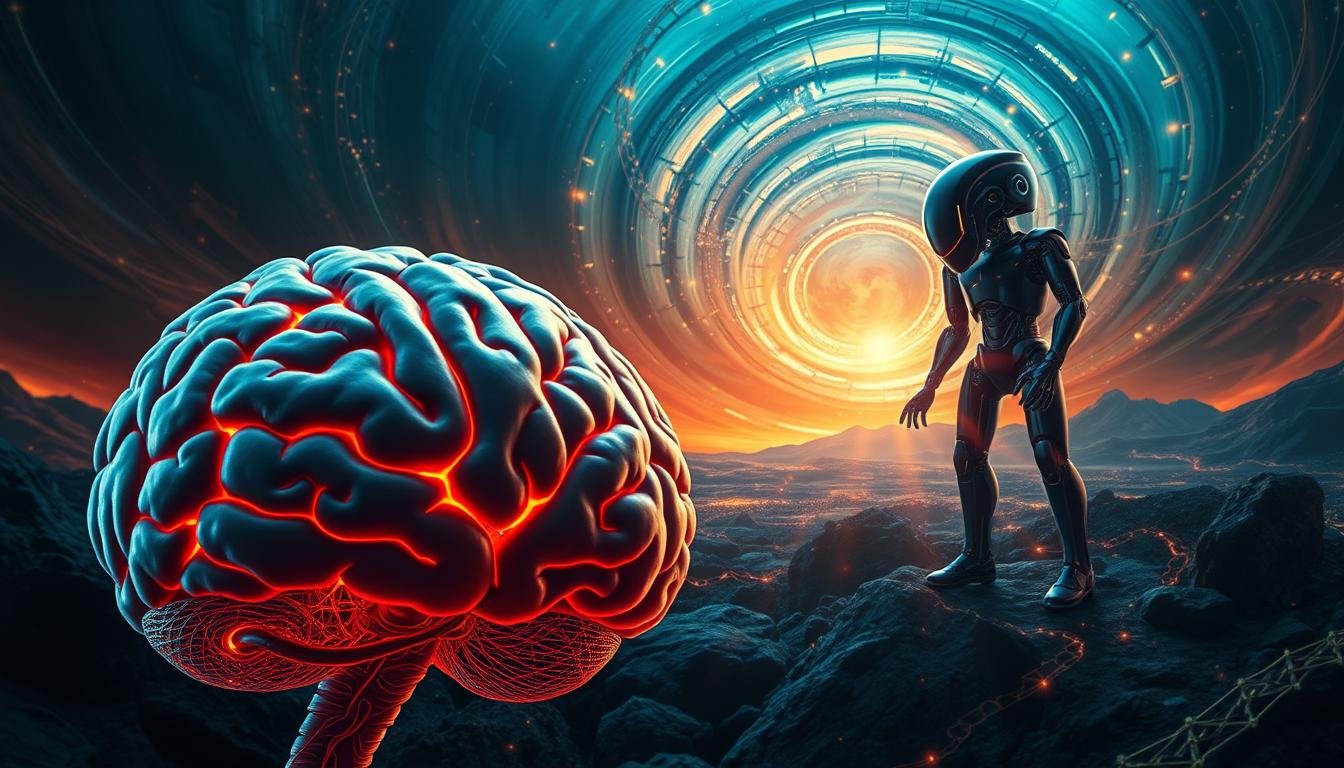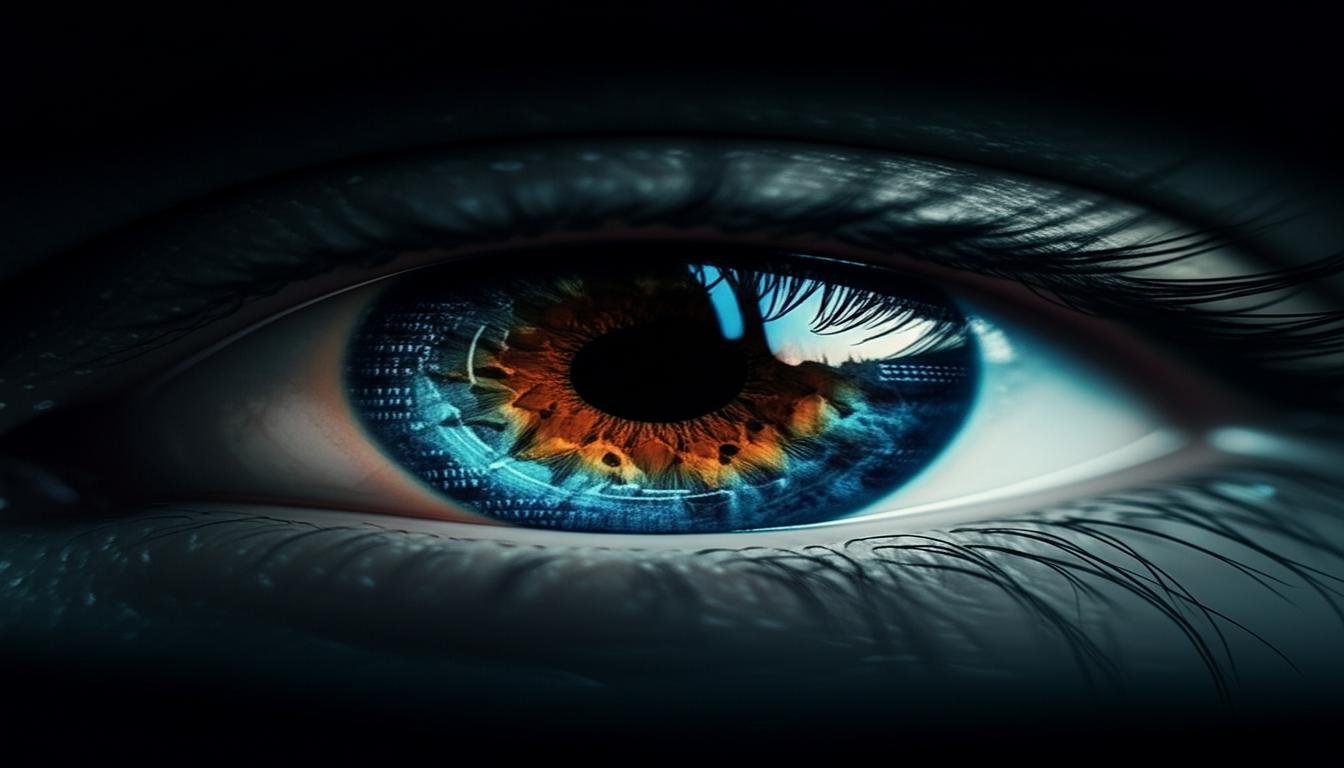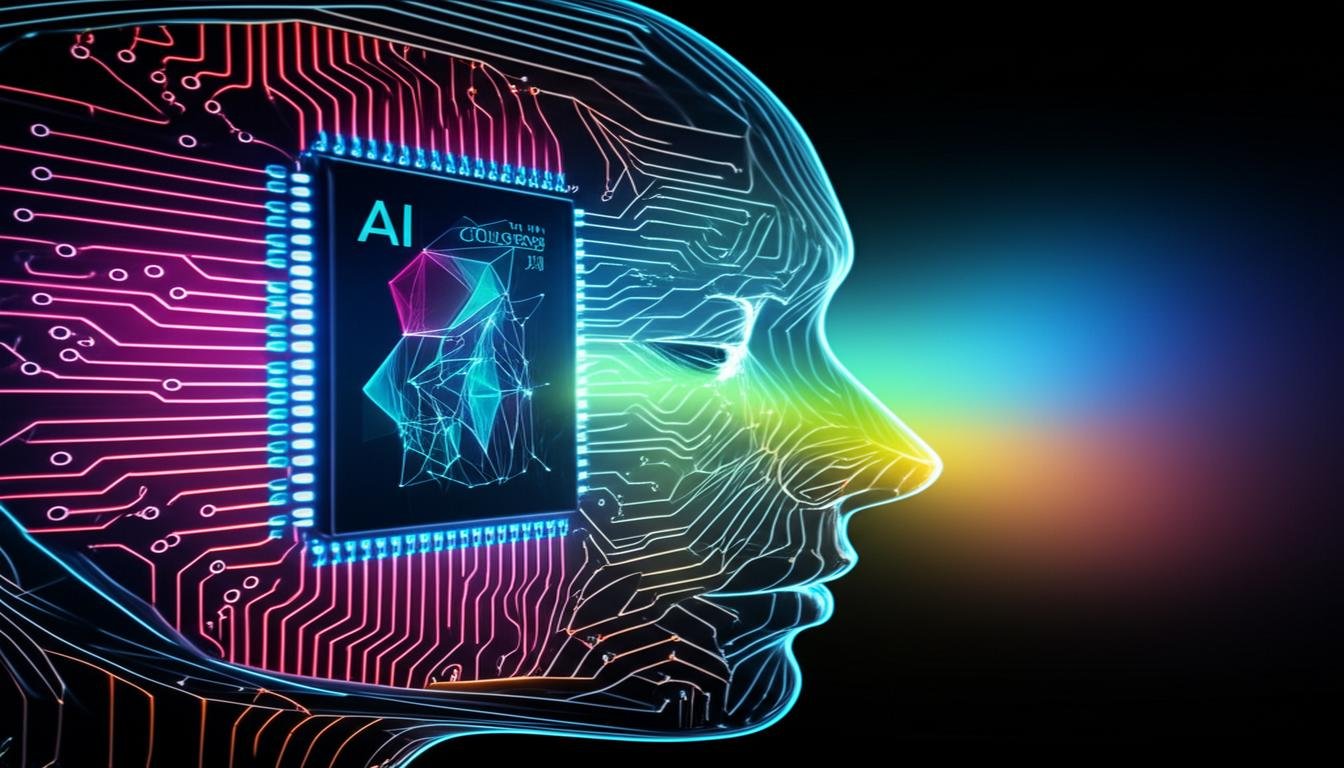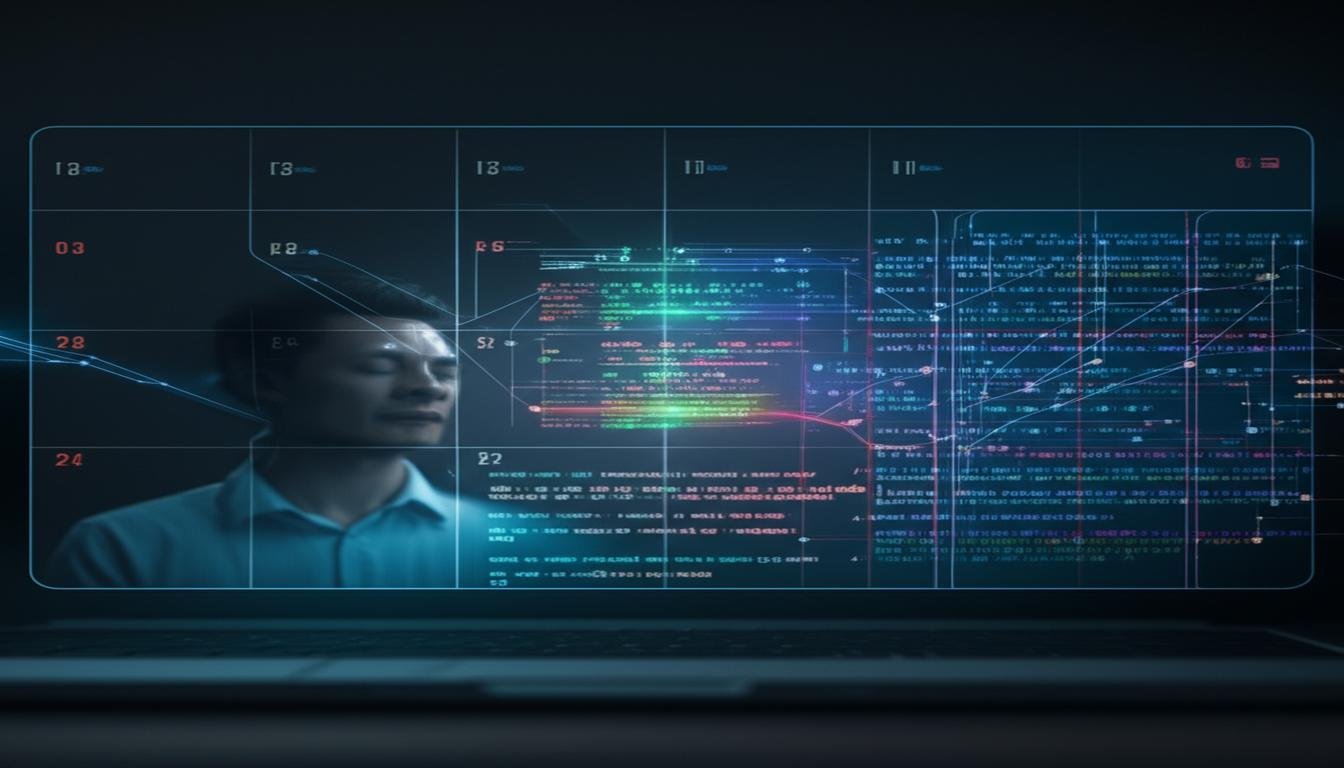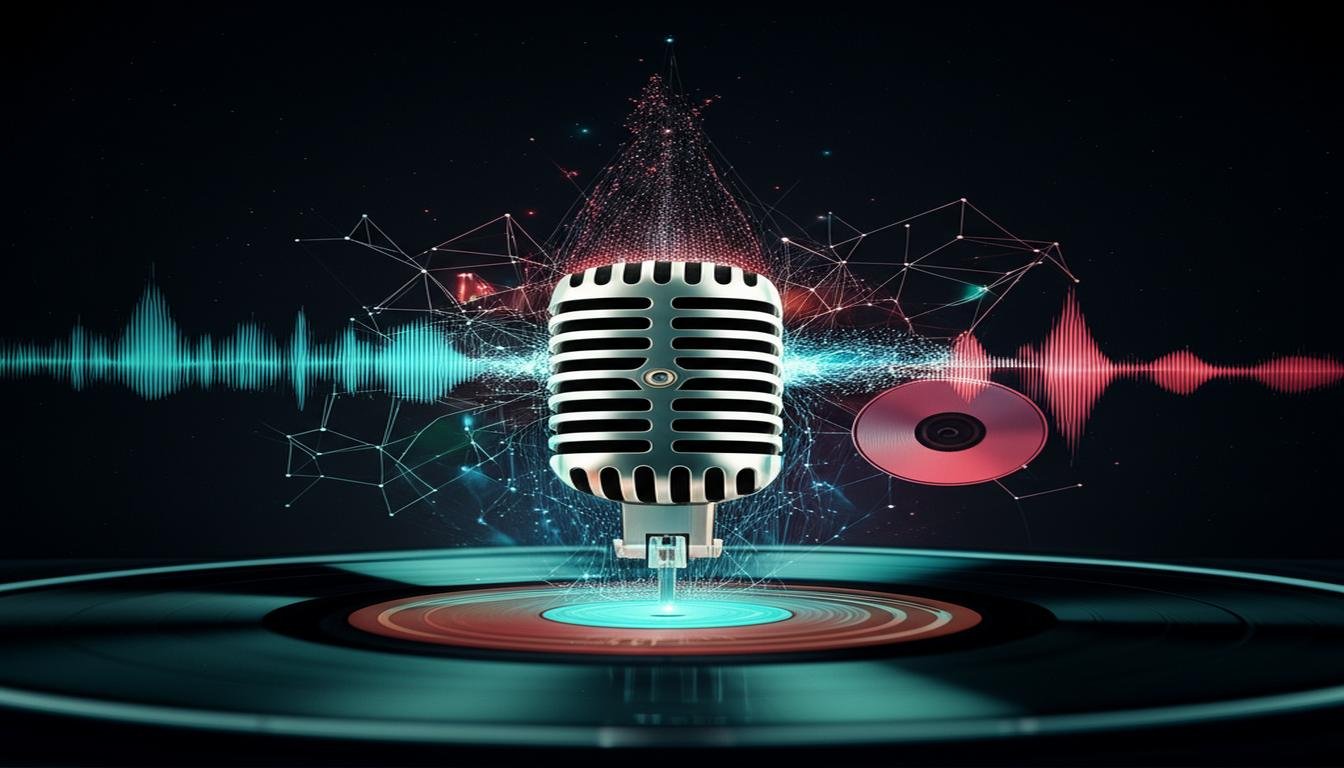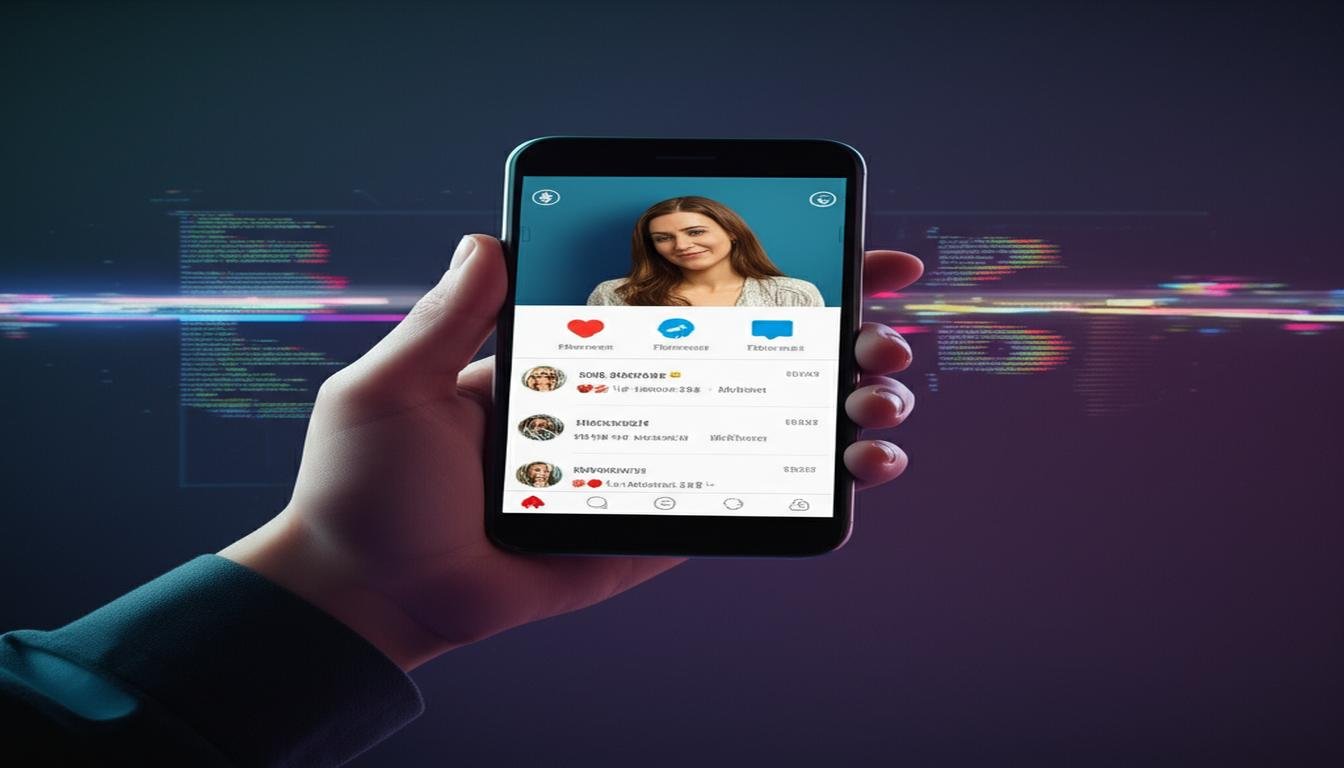Did you know the world’s most advanced AI systems use 500 times more energy than our brains do for similar tasks? This fact from Johns Hopkins’ OneNeuro initiative shows how different and similar natural and machine intelligence are. As scientists work to understand these systems, discoveries like Weill Cornell’s AI visual system show how much we have to learn.
We will look at three key areas: learning efficiency, problem-solving approaches, and ethical implications. Our brains are great at learning new things with little data. But AI is better at recognizing patterns than humans in some tasks. Yet, projects like OneNeuro show that combining neuroscience and computer science could lead to big breakthroughs.
Table of Contents
Key Takeaways
- Biological neural networks use energy 500x more efficiently than current AI systems
- Weill Cornell’s visual AI replicates human-like pattern recognition capabilities
- Johns Hopkins’ OneNeuro bridges neuroscience and machine learning research
- Human cognition adapts faster to novel situations compared to AI models
- Ethical considerations differ fundamentally between biological and synthetic intelligence
Understanding these differences is important, not just for learning. It affects how we create medical tools, self-driving cars, and rules for new tech. Let’s dive into what makes our brains and AI special, and where they might take us together.
The Fundamental Nature of Intelligence
What makes a brain intelligent? Humans and machines solve complex problems in different ways. Biological brains use 86 billion neurons working together. Artificial systems rely on math.
Defining Biological vs Artificial Cognition
Your brain works through electrochemical processes perfected over millennia. OneNeuro’s research shows how molecular interactions at synapses enable learning through physical connections. When you memorize a phone number, proteins reshape neural pathways – a process taking minutes but lasting decades.
AI systems work differently. As Qureshi explains, machine learning algorithms adjust numerical weights in artificial neural networks. These digital “neurons” lack physical form, processing data through layered calculations. While your brain uses 20 watts (enough to power a dim bulb), training advanced AI models consumes enough energy to run a small town.
Three key differences stand out:
- Adaptation speed: Humans learn from single experiences; AI needs thousands of data points
- Energy efficiency: Biological systems use 100,000x less energy per calculation
- Failure modes: Brains forget gradually; AI models crash catastrophically
Yet similarities exist. Both systems excel at pattern recognition – whether identifying faces or predicting stock trends. Recent studies show biological brains and artificial networks develop comparable hierarchical structures when solving similar problems.
The biggest surprise? Your brain’s 86 billion neurons work together through chaotic yet precise signaling. AI’s artificial networks follow strict mathematical rules. This fundamental difference explains why humans grasp abstract concepts effortlessly, while AI struggles with tasks a toddler masters.
Biological Blueprint: Human Brain Architecture
The human brain is like a biological supercomputer. It processes information through 86 billion neurons and 100 trillion synapses. This network is much larger than the most advanced AI systems, which have only hundreds of layers.
Recently, scientists at Johns Hopkins University made a big breakthrough. They created Neuropixels probes that can record activity from over 1,000 neurons at once. This is a huge step in understanding our brain’s biological blueprint.
Also Read: Essential Facts about AI
How Natural and Artificial Networks Stack Up
Biological brains change through neuroplasticity. They rewire connections based on what we experience. AI systems try to do the same by adjusting digital “weights” in their networks.
Dr. Aliya Qureshi uses a city traffic analogy to explain the difference. “Human neurons are like organic road networks that change every day. AI layers are like fixed highway systems that are optimized for speed.”
There are three main differences between biological and artificial networks:
- Energy use: Your brain uses 20 watts, like a lightbulb. Training large AI models uses as much energy as a nuclear plant.
- Learning speed: Humans can learn facial recognition quickly. AI needs millions of labeled images to learn the same thing.
- Failure recovery: If a brain region is damaged, other areas can take over. AI systems often crash if a node is missing.
JHU’s neural recording technology shows another important difference. Biological networks can handle multiple data types at once. Current AI systems can only handle one data modality at a time. But, multimodal models are starting to close this gap.
Biological complexity comes with a cost. While your brain can easily form new connections when learning something new, AI networks need to be completely retrained. But, AI systems are faster at recognizing patterns. They can analyze thousands of X-rays in minutes, compared to a radiologist’s workweek.
Cognitive Capabilities Compared
When we look at human vs machine intelligence, we see big differences in how they process information. Studies from Weill Cornell Medicine show humans use many brain areas at once for visual tasks. This includes context, memory, and emotion. On the other hand, AI uses layered math to analyze pixel patterns, doing well at scale but missing the big picture.
Pattern Recognition Showdown
Humans are great at recognizing patterns because of adaptive intuition. When we see faces, we adjust for lighting or aging without thinking. This skill comes from billions of neurons working together. Dr. Aisha Qureshi’s work shows radiologists use more than just scan data to find tumors, like patient history.
AI systems have a different approach:
- Analyze 10,000+ images per second
- Detect micro-patterns invisible to humans
- Maintain consistent accuracy over time
Memory Systems Analysis
Our memory is shaped by cognitive abilities and emotions. Johns Hopkins studies show dopamine makes memories stick, which is why we remember emotional events well. This is different from machine learning systems, which use algorithms to recall information.
| Feature | Human Memory | AI Memory |
|---|---|---|
| Storage Mechanism | Synaptic connections | Weight matrices |
| Recall Speed | 0.5-2 seconds | Nanoseconds |
| Error Correction | Reconsolidation | Backpropagation |
AI can store huge amounts of data without error. But, it can’t filter information like humans do. Our brains focus on what’s socially important, which helps us make better decisions than AI.
Processing Speed: Human Brain vs Artificial Intelligence
The human brain and artificial intelligence work in different ways. AI is super fast, processing data quickly. But, the brain uses chemical processes that are efficient, not just fast. This shows both systems have unique strengths.
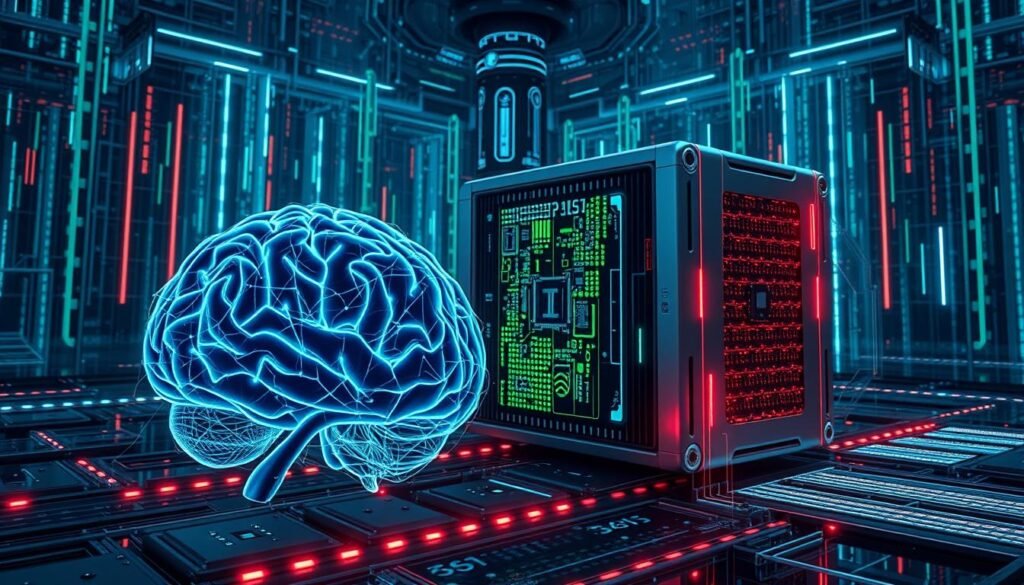
Neural Impulse Speeds vs Clock Rates
The brain sends signals at about 120 meters per second. This is slower than USB cables. Each signal takes 20 milliseconds to travel, causing a delay.
On the other hand, modern GPUs work in nanoseconds. They do billions of calculations before a brain cell fires.
| Metric | Human Brain | AI System |
|---|---|---|
| Base Processing Unit | Neuron (86 billion) | Transistor (billions per chip) |
| Signal Speed | 120 m/s | ~200,000 km/s (light speed) |
| Energy Efficiency | 20 watts | 300+ watts (high-end GPU) |
This speed difference shows both have unique strengths:
- AI is great at quick data processing (like stock market predictions)
- Human brains are better in unclear situations needing thought
- Together, they create hybrid intelligence (human insight + AI speed)
The 20ms neural delay isn’t a bug – it’s an evolutionary feature allowing integration of multiple cognitive systems, explains robotics researcher Dr. Amara Qureshi. Her team found that surgical robots combining AI speed with human operators’ delayed feedback made 23% fewer errors in complex procedures.
AI systems use their speed for tasks like:
- Real-time language translation
- High-frequency trading algorithms
- Autonomous vehicle decision-making
But, human brains make up for it with parallel processing and flexible focus. While AI can quickly solve a chess move, humans think on multiple levels. This is why we’re better at solving open-ended problems.
Learning Mechanisms Under the Microscope
Learning is very different for humans and computers. Humans learn through changing their brain connections. Computers, on the other hand, use math to get better.
Neuroplasticity vs Machine Learning
Your brain is like a sculptor, always changing its paths based on what you do. Research at Johns Hopkins University shows how neurons get stronger when they work together a lot. This is called Hebbian learning.
When you learn something new, your brain makes certain paths better. This happens through myelin sheath development and more branches on neurons.
Computers learn in a different way. They use math to make themselves better. For example, they can learn to recognize handwriting really fast, much faster than humans.
| Aspect | Neuroplasticity | Machine Learning |
|---|---|---|
| Core Mechanism | Hebbian learning (“cells that fire together wire together”) | Backpropagation (error minimization through gradient descent) |
| Speed | Days/weeks for skill mastery | Minutes/hours for task optimization |
| Energy Use | 20W (human brain) | 300W+ (training GPT-3) |
| Failure Recovery | Spontaneous rerouting (stroke recovery) | Full retraining required |
Recent studies show interesting similarities. OneNeuro is working on using brain principles to make AI learn better. Hopkins has also found that neurons can change in ways similar to how AI does, but much slower.
There are three main differences between how humans and computers learn:
- Data efficiency: Kids learn language from 50M words, AI needs 300B tokens
- Transfer learning: Humans can use cooking skills for chemistry, but AI finds it hard
- Energy use: The brain uses less power than a laptop lightbulb during complex tasks
These differences suggest we might create new systems that learn like humans but are as powerful as computers. By mixing the brain’s efficiency with the computer’s power, we could make learning systems that are both smart and scalable.
Decision-Making Paradigms
Decision-making shows big differences between humans and AI. Humans mix logic with feelings, while AI sticks to its rules. This difference affects everything, from our choices to how cars drive themselves.

Emotional Intelligence Factor
Human choices often come from our feelings, not just logic. Johns Hopkins University’s rat addiction studies show this. Rats chose cocaine even when it hurt them, showing how feelings can win over reason.
This explains why we might:
- Buy things on impulse when we’re upset
- Choose quick wins over long-term goals
- Change our minds based on what others think
These insights are key for treating addiction and changing behavior. But AI doesn’t feel or hesitate. It just follows its rules.
Algorithmic Decision Trees
AI uses decision trees to make choices. These trees follow simple paths to decide. For example, self-driving cars use these to:
- Look at road conditions
- Figure out if they might crash
- Follow safety plans
This method is reliable but faces ethical gray areas. AI ethicist Qureshi points out:
Machines can make roads flow better, but they can’t decide between saving a driver or a pedestrian like we do in emergencies.
The gap between AI and humans is clear in medicine. Doctors think about a patient’s feelings and test results. But AI only looks at the numbers.
Energy Efficiency Metrics
When we compare human and artificial intelligence, we see a big difference in energy use. Modern AI systems do amazing things, but they use a lot of energy. This shows how different biological and technological systems are in how they use energy.
Metabolic Costs of Human Cognition
The human brain uses about 20 watts of power, like a dim light bulb. It runs on glucose and does a lot with little energy. Scientists say our brains do 1 exaFLOP (a billion billion calculations) every day using just 20 watts.
Biological systems achieve energy efficiency through millions of years of evolutionary pressure – something silicon-based systems are just beginning to approach.
Three main things help our brains use energy well:
- Parallel processing across 86 billion neurons
- Integrated cooling through blood circulation
- Self-repair mechanisms minimizing energy waste
Data Center Energy Demands
Modern AI systems use a lot more energy. Training GPT-3 used 1,287 MWh of power, enough for 120 homes for a year. Data centers need:
| Component | Human Brain | AI System |
|---|---|---|
| Power Source | Glucose | Electrical Grid |
| Daily Consumption | 0.5 kWh | 50,000+ kWh |
| Efficiency per Task | 10^16 ops/J | 10^9 ops/J |
| Cognitive Tasks | Multi-domain | Specialized |
This big difference comes from how we and AI systems work. Our brains do many things at once, while AI systems do one thing at a time. This makes AI systems use a lot of energy. Server farms also need extra power to cool, which adds to the energy use.
The human vs computer intelligence energy gap is a challenge and an inspiration. Scientists are working to make AI systems use less energy. They want to close the big gap in processing speed per watt.
Creative Problem-Solving Face-Off
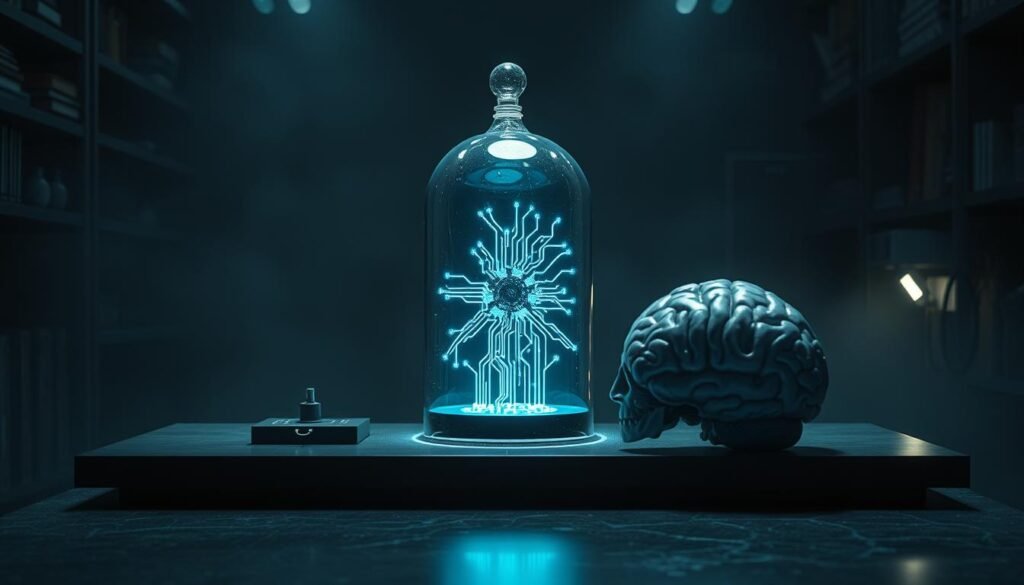
Humans and AI tackle challenges in different ways. Humans use emotions and patterns, while AI looks at data. This makes solving open-ended problems interesting.
The Dance of Human Intuition
Studies at Johns Hopkins University show how humans solve problems. They mix sensory input with experience for quick insights. Our brains:
- Compare memories with what’s happening now
- Balance emotions with logic
- Find solutions through creative thinking
This method leads to breakthroughs, like using spider web patterns for new materials. AI might not see these connections without being told.
Generative AI’s Combinatorial Playbook
Modern AI, like GPT models, is very creative within limits. It suggests new plot twists, like in “Inception”. AI:
- Looks at millions of stories
- Finds patterns that work well
- Mixes different ideas together
But AI can’t come up with completely new ideas. An MIT researcher says:
AI does great variations of known themes, but can’t start new genres.
Lateral Thinking Showdown
Humans are great at making unexpected links. For example, they see connections between Renaissance art and modern design. Our brains:
- Make surprising connections
- Take risks based on feelings
- Use senses to understand the world
AI can’t do this yet. It can make lots of logos fast, but it doesn’t get cultural context or human needs. These are areas where humans are better.
The best way to solve problems is to mix human and AI methods. Doctors use AI to look at genes, then use their own insight to find treatments. This shows we can work together, not just compete.
Ethical Decision-Making Capacity
To understand ethics in humans and AI, we must look at both their biology and programming. Humans learn morality through life and social norms. AI, on the other hand, uses data and rules set by humans. This difference makes it hard to compare their ethical choices.
Moral Reasoning in Biological Systems
Humans start learning about right and wrong early in life. This learning happens through brain areas like the prefrontal cortex and limbic system. Research at Johns Hopkins University shows that chemicals in the brain can change how we see ethics.
Mirror neurons are key in understanding others’ feelings. They help us feel what others feel and react to moral issues. These brain cells grow as we interact with others over time.
This explains why humans make ethical choices based on context and culture. It shows why our decisions are often nuanced and influenced by our surroundings.
AI Ethical Frameworks
AI faces big challenges in making ethical choices:
- It’s hard to measure abstract ideas like fairness.
- It must balance different ethical values in its training data.
- It struggles to be consistent across different cultures.
Researcher Qureshi’s work on bias mitigation algorithms shows how AI tries to follow ethics. These systems use mathematical rules to guide their decisions.
| Aspect | Human Approach | AI Approach | Key Challenges |
|---|---|---|---|
| Basis | Neurochemical responses | Mathematical models | Quantifying subjectivity |
| Adaptability | Lifelong learning | Version updates | Real-time adjustments |
| Emotional Influence | Integrated factor | Programmed exclusion | Recognizing affective data |
AI systems find it hard to handle exceptions, or “gray areas.” Humans are good at recognizing these situations through intuition. AI can process many scenarios quickly but lacks true empathy, which is key for human judgment.
Language Processing Abilities
From babbling infants to advanced chatbots, language learning is vastly different. Human brains learn language through social interactions. AI systems, on the other hand, use big datasets to recognize patterns. This difference leads to unique strengths and weaknesses in how each understands meaning and context.
Natural Language Acquisition
Children learn language through play and emotional connections, not just drills. Research from Johns Hopkins University shows toddlers pick up 2-3 new words every day. They do this through:
- Social reinforcement during shared activities
- Contextual guessing from facial expressions
- Error correction through caregiver feedback
This natural learning process helps children develop pragmatic competence. They learn to adjust their language based on social cues. Humans can pick up on sarcasm and implied meanings, skills that are hard for AI to match.
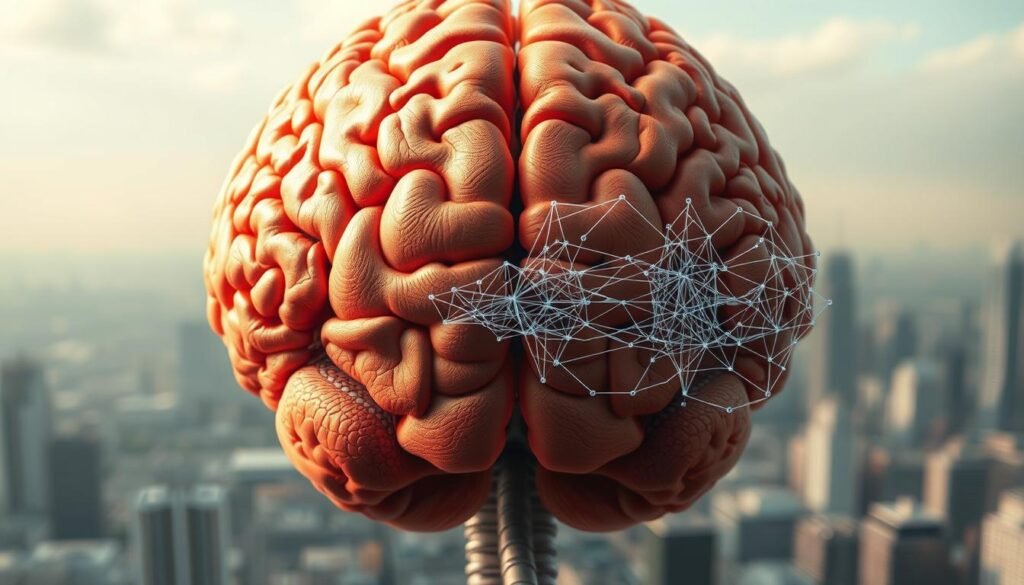
Large Language Models Analysis
AI systems like GPT-4 process language in a different way. They use neural networks trained on text patterns. These models can create responses that seem human-like, but their approach is unique:
| Aspect | Human Brain | LLMs |
|---|---|---|
| Learning Source | Multisensory experiences | Text datasets |
| Context Understanding | Cultural references | Word co-occurrence |
| Error Correction | Social feedback | Reinforcement learning |
Qureshi’s study on chatbots shows a big gap. AI often misses emotional cues that humans pick up through tone and body language. While LLMs can generate likely responses, they don’t truly understand the physical world. This limits their ability to grasp human communication fully.
Sensory Perception Comparison
When we look at how humans and AI see the world, we see big differences. Humans have evolved to handle complex data for thousands of years. AI tries to do the same with technology and algorithms. Let’s see how these systems compare and where they fall short.
Biological Sensors vs Machine Inputs
The human eye can see a 200° field of view, much more than AI cameras. This lets humans notice things that robots often can’t. Our ears can hear sounds from 20 Hz to 20 kHz and pick up emotions, something most microphones can’t do.
AI systems use special sensors:
- LiDAR for spatial mapping
- Thermal cameras for heat signatures
- Pressure sensors for tactile feedback
But these tools have trouble with things like fog or overlapping sounds. These are things humans handle easily.
Multimodal Integration Challenges
Researchers at Johns Hopkins found humans can mix sight, sound, and touch 35% faster than AI. For example, self-driving cars struggle to combine visual and auditory information. Humans do this smoothly, but AI needs complex algorithms.
There are three main problems with AI’s multimodal integration:
- Getting sensors to work together in time
- Interpreting conflicting data
- Understanding the context
Neural networks have made progress, but AI is far from matching the brain’s ability to blend senses.
Failure Modes Analysis
Understanding how humans and AI systems fail is as important as knowing their successes. Humans make mistakes 23% of the time in complex decisions, while AI fails only 2% of the time. Yet, the nature of these failures is vastly different, with serious consequences in healthcare and finance.
When Human Judgment Goes Astray
Our brains have cognitive biases – mental shortcuts that lead to errors. Doctors often favor diagnoses that match their initial thoughts, leading to 38% of misdiagnoses, as Johns Hopkins research shows. Three biases affect our decision-making:
- Anchoring effect: Over-relying on first impressions
- Availability heuristic: Judging likelihood by recent memories
- Overconfidence: 75% of surgeons overestimate their diagnostic accuracy
Biological brains aren’t designed for pure logic – they’re survival machines that prioritize speed over accuracy, notes Dr. Ellen Reyes from MIT’s Cognitive Science Lab.
The AI Hallucination Paradox
AI systems make fewer mistakes, but their 2% error rate hides hallucinations – confident false outputs. Qureshi’s 2023 study found GPT-4 gives medically inaccurate advice 1 in 50 times when asked about rare diseases. These errors are different from human mistakes:
| Factor | Human Errors | AI Hallucinations |
|---|---|---|
| Error Rate | 23% | 2% |
| Failure Type | Predictable biases | Random false patterns |
| Example | Misreading lab results | Inventing fake medications |
This creates unique challenges for medical AI systems. While human doctors might overlook a symptom due to fatigue, an AI could recommend a non-existent treatment protocol with absolute confidence.
The solution is hybrid systems. Radiologists using AI checklists reduce diagnostic errors by 41%. AI models trained on bias-aware datasets show 67% fewer hallucinations. As Dr. Alicia Tan at Stanford Hospital explains: “We need human intuition to catch AI’s blind spots, and machine precision to override our cognitive shortcuts.”
Collaborative Potentials Explored
The most exciting developments in cognitive technology happen when humans and AI work together. Neuralink’s trials and Johns Hopkins University’s Parkinson’s disease research are leading the way. They show how biological and digital systems can cooperate, improving human abilities and using AI’s power.
Brain-Computer Interfaces
Modern brain-computer interfaces (BCIs) like those in JHU’s studies are very promising. They turn brain signals into digital commands. This lets patients with Parkinson’s control devices with their thoughts.
BCIs are special because they work both ways. The brain and algorithms learn from each other through feedback.
- Signal resolution increased by 300% in 2020
- AI reduces noise in neural data
- Non-invasive methods match 70% of implant precision
Augmented Intelligence Systems
Augmented intelligence systems help humans make better decisions, not replace them. Dr. Aliya Qureshi’s robotics research shows this with factory robots that adjust based on feedback. These systems are great for tasks needing both human insight and machine accuracy.
Now, we’re seeing new uses for these systems:
- Medical tools suggest treatments but let doctors decide
- Manufacturing robots learn from experienced workers
- Financial analysis platforms highlight risks and explain them
The future is about humans and AI growing together,” says MIT’s Human-AI Collaboration Lab. “Our neural lace prototypes show how biological and artificial networks can share knowledge.
But there are ethical concerns as these technologies grow. Neural lace ideas raise questions about privacy and control over our minds. Current rules focus on three main areas:
- Users must control their neural data
- AI decisions must be transparent
- BCIs for military use are restricted
As these systems improve, they promise to create new kinds of intelligence. They will mix human creativity with machine efficiency. The challenge is to design systems that keep human control while unlocking new partnerships.
Future Evolution Trajectories
The next decade will change how humans and machines evolve. We’ll see two main paths: upgrading our brains and creating artificial general intelligence (AGI). Experts like roboticist Aliya Qureshi think these paths will come together. They will create systems that use the best of both.
Human Cognitive Enhancement
Research is finding ways to make our brains better. Project Hopkins showed how to improve memory by 40% using special triggers. Key advancements include:
- Neuroprosthetics that connect directly with brain areas
- CRISPR gene editing for better brain chemicals
- Nootropics that mimic AI learning
Studies by OneNeuro suggest our brains could soon match AI speeds. But, there’s a big question: will these upgrades create unfair advantages or help everyone?
Artificial General Intelligence
Creating AGI is tough. Today’s AI is great at specific tasks but not flexible like humans. Qureshi believes by 2025, we’ll solve three big problems:
- Understanding different contexts
- Finding problems on their own
- Making ethical choices without humans
The “symphony of components” method uses neural networks, symbolic AI, and quantum computing. Early tests show AI can do creative tasks. But, achieving true general intelligence is a big challenge. Dr. Ellen Park says:
We’re teaching machines to think, not just calculate – that’s the real breakthrough.
Experts think upgrading our brains might happen before AGI. This gap could lead to human-AI collaboration systems. The goal is not to compete but to evolve together.
Conclusion: Symbiotic Future Prospects
Exploring human cognition and artificial intelligence shows their strengths complement each other. Human brains are great at creative thinking and making moral choices. AI, on the other hand, is a master at handling data and spotting patterns. This mix is key to a future where humans and AI work together to solve big problems.
Places like Johns Hopkins University are already showing how this collaboration works. They bring together neuroscientists and AI experts to create new brain-computer interfaces. These tools help humans make better decisions, tackling issues like health and climate change while dealing with tough ethical questions.
We’re seeing this teamwork in action. For example, AI helps Adobe’s creative team, while humans ensure AI is used ethically at DeepMind. The future looks bright with AI and human brains working together. Imagine AI that learns and adapts like our brains do, making education more personal and effective.
Creating this future means finding a balance between new ideas and being careful with how we use them. OneNeuro’s work shows how AI and brain mapping can help with mental health. It’s all about using AI to help humans, not replace them, by doing tasks that need speed and scale.
Your part in this partnership is to learn about both AI and human abilities. Whether you’re making AI tools or using them, focus on improving human judgment. The biggest breakthroughs will come from teams that value both human creativity and AI’s precision.
FAQ
How does human brain architecture differ from artificial neural networks?
The human brain has 86 billion neurons and 100 trillion connections. These connections are made through electrochemical processes. Artificial networks, on the other hand, use algorithms and have fixed layers. Johns Hopkins researchers used neural probes to show these differences. They recorded over 1,000 biological neurons at once. This contrasts with AI’s static architecture. Unlike AI’s backpropagation, biological systems like those studied by OneNeuro show molecular-level plasticity. This allows for continuous rewiring.
Can AI match human visual processing capabilities?
Weill Cornell’s fMRI research shows the brain processes visual information in a complex way. It uses distributed cortical networks and contextual understanding. AI’s convolutional networks are great at pattern detection but lack semantic integration. AI achieves 99% accuracy on image classification benchmarks. But it struggles with novel perspectives that humans handle instinctively. This gap is highlighted in Johns Hopkins’ multisensory perception studies.
Why do humans make more errors than AI systems?
AI systems like diagnostic algorithms have 2% error rates, while humans have 23% in controlled tasks. But Johns Hopkins’ addiction research shows human decisions include emotional context. This prevents catastrophic failures. Qureshi’s GPT hallucination studies show AI’s brittleness when facing new scenarios. Human cognition’s adaptive error-correction is honed through evolution.
How does biological learning differ from machine learning?
Human neuroplasticity combines dopamine-driven Hebbian learning with structural changes. Hopkins’ Purkinje cell imaging shows this. AI relies on backpropagation through labeled datasets like MNIST. OneNeuro’s synaptic research reveals biological systems make continuous micro-adjustments. This allows for real-world adaptation without forgetting. AI’s batch training is different.
Are AI systems more energy efficient than human brains?
The brain operates on 20 watts, like a dim bulb. Training GPT-3 consumed 1,287 MWh. But Johns Hopkins researchers note biological systems optimize glucose metabolism through evolution. Qureshi’s robotics work shows current AI struggles with real-world energy efficiency. Despite superior computational throughput, AI is not as efficient as the brain.
Can AI truly replicate human creativity?
Generative AI like DALL-E recombines training data. But Hopkins’ movement studies show human creativity comes from embodied cognition and conceptual leaps. AI lacks intentionality – biological systems create meaning. True innovation remains uniquely human until artificial general intelligence emerges.
How do ethical decisions differ between humans and AI?
Johns Hopkins’ psilocybin research shows human morality integrates emotional resonance and social context. AI ethics rely on programmed frameworks like Qureshi’s fairness algorithms. Current systems struggle with empathy encoding. Empathy is a biological strength developed through millennia of social evolution. It resists mathematical formalization.
Will brain-computer interfaces surpass pure AI development?
Hopkins’ Parkinson’s research shows current BCI tech achieves 94% movement prediction accuracy. Qureshi’s neural lace prototypes suggest hybrid systems may combine biological intuition with AI processing. But the brain’s electrochemical complexity, like the hippocampus studied by OneNeuro, presents integration challenges. These challenges may favor augmented intelligence over full replacement.

